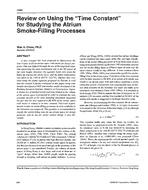A time constant has been proposed to characterise the time it takes to fill an atrium space with smoke for design purposes. This was defined through the use of the empirical equation expressing the mass entrainment rate to the 3/2 power of the clear height. However, the equation holds only when the flame tip touches the smoke layer, and the flame temperature was taken to be 1100 K (827degC 1521degF). Another time constant using the plume equation proposed by Zukoski is used and the concept is further evaluated using zone models developed at NIST and another model developed at the Building Research Institute, Ministry of Construction, Japan. A design fire of thermal power and area related to the volume of the atrium space is proposed in order to evaluate the time constant. Results of the zone modelling simulation supported the fact that the time required to fill 80% of the atrium space with smoke is related to its time constant. Full-scale experimental results on smoke-filling processes in atria available in the literature are compared. This quantity is recommended to specify the smoke-filling time for an atrium space for design purposes, and its use for smoke control design is also discussed.
Units: Dual
KEYWORDS: year 1997, Smoke ventilation, control, measuring, smoke, artria, time, designing, air change rate, air flow, jets, calculating, comparing
Citation: ASHRAE Transactions, Vol.103, Part 2, Boston 1997
Product Details
- Published:
- 1997
- Number of Pages:
- 11
- File Size:
- 1 file , 970 KB
- Product Code(s):
- D-16436
